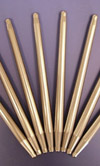Its all in the tip
 According to Dr Andy Randolph, engine technical director at NASCAR championship contenders Earnhardt Childress Racing, the interesting period for pushrod development was a couple of years ago. “Many teams were looking into alternative materials for a stiffer, yet lighter solution, compared to the traditional chrome moly steel” that had been in use for many years.
According to Dr Andy Randolph, engine technical director at NASCAR championship contenders Earnhardt Childress Racing, the interesting period for pushrod development was a couple of years ago. “Many teams were looking into alternative materials for a stiffer, yet lighter solution, compared to the traditional chrome moly steel” that had been in use for many years.
Dr Randolph notes that the exotic materials solutions produced some beneficial effects, but to his mind, the cost-to-benefit trade-off just did not make the grade.
“There may be some teams who feel otherwise,” he said.
“The challenge with many of the composites is getting a hole up the centre of the pushrod for oiling the pushrod/rocker interface, and complying with the ‘magnetic’ rule from NASCAR,” Dr Randolph continued. The ‘magnetic’ rule (20.5 8.2, Section F) permits “Only magnetic steel one-piece pushrod assemblies without any moving parts.”
“To the best of my knowledge, most teams found the considerably more expensive pushrods offered very little benefit, because mass savings on the pushrod side of the valvetrain do not translate readily to performance gains,” Dr Randolph recalled. “In fact, the trend over the past several years has been towards thick, stiff, heavy steel pushrods.”
While most race-related parts tend toward the lighter end of the spectrum, in the case of pushrod technology, “Mass on the cam side of the rocker does not impact valve event dynamics nearly as much as mass on the valve side. In some cases, increased mass can improve high-speed performance,” Dr Randolph told me, by generating more loft (dynamic valve lift) past the nose of the cam.”
The only variations have been in single-piece versus three-piece pushrods with pressed-in tips, and straight versus tapered designs, in the realm of recent NASCAR use.
The single piece designs offer “excellent reliability but the roller tip shape is not optimal,” because of the manufacturing processes necessary to compress the material on the ends of the tube to form the spherical lobes that mate with the rocker – or swedge – a single tube.
The manufacturing cost differences, according to Dr Randolph, are miniscule between various designs of steel pushrods as compared with the costs of utilising exotic materials. “Conversely, three-piece designs offer the potential for extremely accurate ends, plus the opportunity to use different alloys for the ends, as opposed to the shaft.
“Unfortunately,” he noted, “the pressed-in tips can compromise reliability. Pressed-in tips create a stress and interface at the ends of the pushrods that do not exist in a single-piece swedged design. However, manufacturing the tips separate from the body of the pushrod allows the option to use different materials and can result in more precise ends. Both types are used commonly” in the NASCAR engine building community.
Because pushrods have a minor impact in engine performance but a more significant impact on valvetrain durability, Dr Randolph explained, the dynamic performance of the valvetrain system is definitely impacted by pushrod design. “This is a valvetrain systems design issue,” he noted. “What ‘works best’ will vary depending on the complete
valvetrain system.”
Dr Randolph does vary the pushrod design to change stiffness and frequency characteristics of the valvetrain. Replacement of units occurs when “we start to see any sign of wear on the ball,” he said. There are different designs for different applications, including plate races, but Dr Randolph is adamant that “they all last forever!”
Written by Anne Proffit.